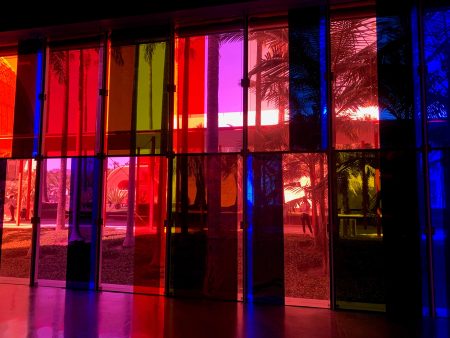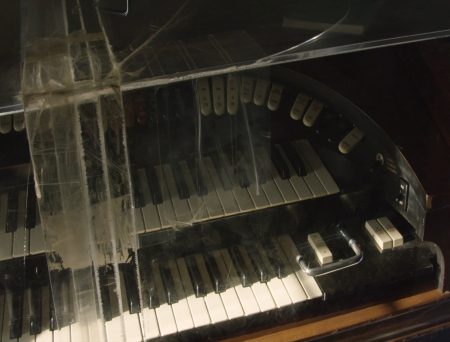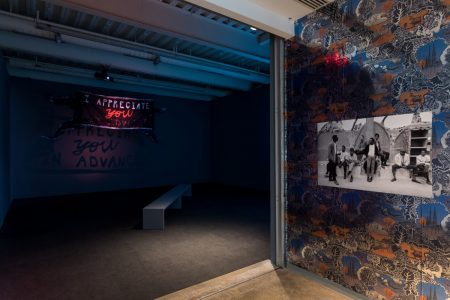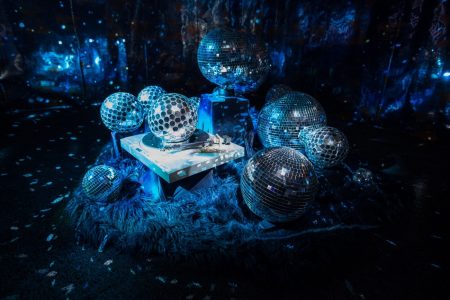Give It Or Leave It is on view at the LACMA until October 31, 2021
Due to the Covid-19 pandemic my visit to the newly reopened Los Angeles County Museum of Art (LACMA) felt a bit utopian to me, allowing me to feel – in the words of Jose Esteban Muñoz – the then and there, or the hopefully near future in which our culture will reach collective recovery. Among the collection of interesting exhibitions on view currently, it’s fitting that one of them would be a rather remarkable artistic utopia. Cauleen Smith brings us a multi-faceted, multi-formatted utopia of nuanced black feminism. This utopia, finally accessible in person, holds particular relevance in light of the conviction of George Floyd’s murderer. Smith utilizes video, photography, music, and collected artifacts to perform dialogues with the likes of Alice Coltrane, the Combahee River Collective and Noah Purifoy of the Watt’s Towers. She builds on these voices to enact a speculative exploration of space. The exhibition interrogates who is allowed to occupy space in an unabashedly white world and how? How can black spaces be created and defended? What constitutes a black, feminine, or queer utopia? How can multiple spaces be bound together into one larger space? Smith’s exhibition Give It Or Leave It imagines a utopia that welcomes the contemplative mind of any patron passing through the corridors of the LACMA.
I consult with Jose Muñoz book Cruising Utopia for a vital theory of utopia. For Muñoz, queers and people of color should imagine utopias as, “profoundly resistant to the stultifying temporal logic of a broken-down present” (13). Further he writes on queerness, “as a temporal arrangement in which the past is a field of possibility in which subjects can act in the present in the service of a new futurity” (16). This form of utopia runs counter to what popular audiences may envision when they think of the word. For Muñoz utopias draw on the past, in order to confront the present. They’re sites that create or use space for communal calibration of the eyes toward both history and the future. Smith operates in this mode, unafraid to acknowledge the ongoing effects of complex histories on black and feminine life. Her utopia doesn’t attempt a rupture from our current reality, but rather communicates with it directly.

I was immediately struck by the utopian nature of the exhibition space itself. The rest of LACMA’s exhibitions, like most others, consist of pieces surrounded by sparse, white walls. Most of the space is utilized. The lighting is dim, emanating soft reds and blues. The walls are either covered or projected upon. Smith rejects traditional norms of displaying art, allowing audiences to experience a cohesive environment that feels like a space apart. Even a large window is covered with multi-colored film to reinforce the exhibition as a utopian space, nestled within a larger artistic world. Visitors are guided through the three sections of the exhibition purposefully, which allows for Smith’s political elements to be strewn across those mediums in order to build historical and personal nuance. Give It Or Leave It begins with film footage of Alice Coltrane’s California Ashram – a communal living space that she built to foster musical and spiritual exploration. Smith projects the footage to establish her influences and intentions. She recalls a visit to the Ashram, “I was stricken with this world that she’d built and how her students were still there practicing with the same kind of ethic and generosity that she generated there.”

Pilgrim, 2017
Single-channel video (color, sound); 7 minutes, 41 seconds
Courtesy of the artist, Corbett vs. Dempsey, Chicago, and Kate Werble Gallery, New York
The screen projecting the Coltrane film sits between the multi-colored window and the dividing wall that’s covered with ornate printed wallpaper. In the middle of the wallpaper hangs a photograph of a group of men posing at the base of the Watts towers. The men are all dressed sharply, sitting in what appear to be relaxed dispositions – one crosses his legs. It’s a snapshot of the past that Smith transports into this liminal space of ornate futurism, allowing her to recast the image as a sort of micro utopia. And perhaps to those men in that moment it was a micro utopia. Of course, the photograph was taken for TIME magazine just after the tumultuous Watts Uprising of 1965. If you’ve done your research, the image might catalyze reflection of then LA police chief William Parker’s coinage of the “Thin Blue Line.” The image places Smith’s world as one firmly in response to the timeline that’s seen the Watts Uprising, the Rodney King riots, and the ongoing Black Lives Matter movement. Juxtaposing the image and the footage of Coltrane’s ashram establishes both of Smith’s utopian intentions, as well as her framing of political discourse as a necessary element of establishing said utopia. She insinuates that if the injustices that led Watts don’t happen, utopia isn’t necessary. Unfortunately it is. If the image does indeed depict the men enjoying a micro utopia, it’s one that had to be established within a space that may not have wanted them.

Space Station Chinoiserie #1: Take Hold of the Clouds, 2018
Digitally printed wallpaper
Courtesy of the artist, Corbett vs. Dempsey, Chicago, and Kate Werbly Gallery, New York
The next section of the exhibition expands Smith’s utopia into a melancholy celebration. The top right corner holds a banner that reads, “Afflict the Comfortable, Comfort the Afflicted.” A conglomeration of disco balls sits on the floor, refracting blue light. The cool colors that reflect from the disco balls collaborate with the language of the banner to generate a meditative aggression. Smith asserts a political struggle that must be lived with. Victory and survival must be celebrated. It resembles a nostalgic club where the artist screens her film “Sojourner.” The 22-minute film runs on a loop, inviting audience meditation on footage of the Watts Towers and the Joshua Tree Outdoor Museum – both built by Noah Purifoy. Smith expands on the work of the first section, bringing language from Coltrane and then the Combahee River Collective into new settings. She captures women performing “convivial happenings” around the two spaces, at one point directly recreating the utopian photo from TIME.

Sojourner, 2018
Single-channel video (color, sound); 22 minutes, 41 seconds
Courtesy of the artist, Corbett vs. Dempsey, Chicago, and Kate Werble Gallery, New York
Herein, she inflects the images with the Combahee River Collective’s “Black Feminist Statement,” generating a utopian vision which is “actively committed to struggling against racial, sexual, heterosexual, and class oppression and see as our particular task the development of integrated analysis and practice upon the fact that the major systems of oppression are interlocking.” Women list through the outdoor museum listening to the words of the past while the sun shines on their vibrant, expressive clothing. They walk around the bases of the towers with protest banners that read phrases like, “Sit at the Feet of Action.” Smith’s film imagines womanhood as an artistic act, as well as a spiritual, communal act of resistance and protest, demonstrating her theses with surprising cohesion. She brings exterior, historical spaces into the fold of this one.

Space Station: Two Rebeccas, 2018
Wallpaper, disco balls, turntable, motor, fur, shag carpet, two projectors, and two-channel digital video (color, sound); Rebecca Jackson: 2 minutes, 25 seconds; Rebecca Peroth; 2 minutes, 57 seconds
Courtesy of the artist, Corbett vs. Dempsey, Chicago, and Kate Werble Gallery, New York
The exhibition ends in its third, most opaque, space. One wall is covered with the same ornate wallpaper, while another is projected upon. In the middle sits a large round table covered with scattered objects. In the middle of the table four screens face outward and around the edges sit four CCTV cameras. The cameras record the screens and whatever objects sit between them, producing the images projected onto the walls. The objects are personal to Smith, but they’re chosen to recall jazz and other pockets of African American histories and cultures. The projections and surroundings are meant to evoke a cosmic, ethereal environment, soaked in the damp colors that grant the exhibition an otherworldly feel. It’s a bizarre setup, but it’s consistent with Smith’s project of warping the gallery space. My eye lingered on the cameras, which raise questions about surveillance, identity and culture. The objects and colors allude toward a development of identity as cultural construct. Perhaps the cameras, then, allude toward how identity development is surveilled – especially for people of color and especially when politics come into play. In building this cosmic view of her own interests, I wonder if she is adding to her political project, recalling the lives of revolutionaries like Assata Shakur and Fred Hampton and the role of the surveillance state in upending them.

Epistrophy, 2018
Four CCTV cameras, four monitors, projection, custom wood table, taxidermied raven, wood figures, bronze figures, plastic figures, books, seashells, minerals, jar of starfish, Magic 8-Ball, maneki-neko, mirror, metal trays, plaster objects, wood objects, wire objects, fabric, glass vase, and plant Multichannel video (color, sound); Epistrophy 1: 6 minutes, 57 seconds; Epistrophy 2: 5 minutes, 31 seconds; Epistrophy 3: 5 minutes, 46 seconds; Epistrophy 4: 8 minutes, 23 seconds
Los Angeles County Museum of Art, purchased with funds provided by AHAN: Studio Forum, 2020 Art Here and Now purchase
The exhibition ends on a more open-ended note as the doorway opens back toward white gallery space, reminding you that you’re in a traditional art museum. Cauleen Smith’s utopia has a handful of impressive artistic experiments, but what lingers with me is how she patches together mediums and ideas. They come together to form a space that consciously engulfs the audience in ways that usual gallery spaces don’t. She consults with vital voices (all of which I didn’t even get to) to piece together a complicated utopian vision of womanhood, spirituality, care and resistance. The current political predicaments that she has in mind are often met with incendiary discourse, but Give It Or Leave It feels surprisingly nurturing.
— Josh Beckelhimer



